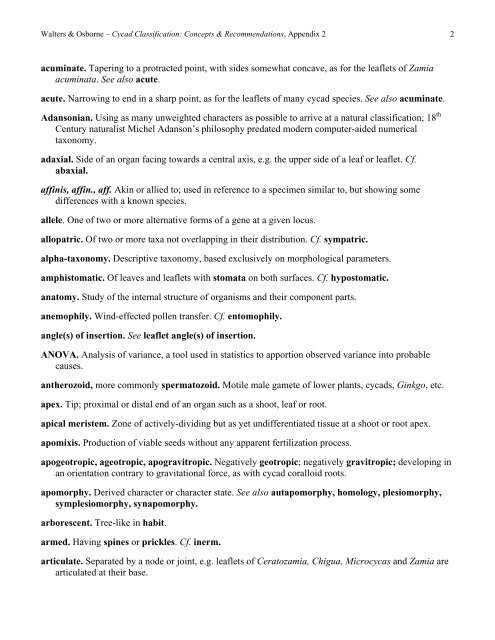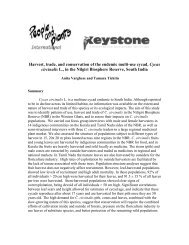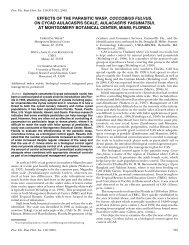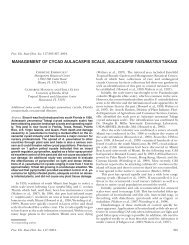Glossary of terms used in cycad systematics - Cycad Specialist Group
Glossary of terms used in cycad systematics - Cycad Specialist Group
Glossary of terms used in cycad systematics - Cycad Specialist Group
Create successful ePaper yourself
Turn your PDF publications into a flip-book with our unique Google optimized e-Paper software.
Walters & Osborne – <strong>Cycad</strong> Classification: Concepts & Recommendations, Appendix 2 2<br />
acum<strong>in</strong>ate. Taper<strong>in</strong>g to a protracted po<strong>in</strong>t, with sides somewhat concave, as for the leaflets <strong>of</strong> Zamia<br />
acum<strong>in</strong>ata. See also acute.<br />
acute. Narrow<strong>in</strong>g to end <strong>in</strong> a sharp po<strong>in</strong>t, as for the leaflets <strong>of</strong> many <strong>cycad</strong> species. See also acum<strong>in</strong>ate.<br />
Adansonian. Us<strong>in</strong>g as many unweighted characters as possible to arrive at a natural classification; 18 th<br />
Century naturalist Michel Adanson’s philosophy predated modern computer-aided numerical<br />
taxonomy.<br />
adaxial. Side <strong>of</strong> an organ fac<strong>in</strong>g towards a central axis, e.g. the upper side <strong>of</strong> a leaf or leaflet. Cf.<br />
abaxial.<br />
aff<strong>in</strong>is, aff<strong>in</strong>., aff. Ak<strong>in</strong> or allied to; <strong>used</strong> <strong>in</strong> reference to a specimen similar to, but show<strong>in</strong>g some<br />
differences with a known species.<br />
allele. One <strong>of</strong> two or more alternative forms <strong>of</strong> a gene at a given locus.<br />
allopatric. Of two or more taxa not overlapp<strong>in</strong>g <strong>in</strong> their distribution. Cf. sympatric.<br />
alpha-taxonomy. Descriptive taxonomy, based exclusively on morphological parameters.<br />
amphistomatic. Of leaves and leaflets with stomata on both surfaces. Cf. hypostomatic.<br />
anatomy. Study <strong>of</strong> the <strong>in</strong>ternal structure <strong>of</strong> organisms and their component parts.<br />
anemophily. W<strong>in</strong>d-effected pollen transfer. Cf. entomophily.<br />
angle(s) <strong>of</strong> <strong>in</strong>sertion. See leaflet angle(s) <strong>of</strong> <strong>in</strong>sertion.<br />
ANOVA. Analysis <strong>of</strong> variance, a tool <strong>used</strong> <strong>in</strong> statistics to apportion observed variance <strong>in</strong>to probable<br />
causes.<br />
antherozoid, more commonly spermatozoid. Motile male gamete <strong>of</strong> lower plants, <strong>cycad</strong>s, G<strong>in</strong>kgo, etc.<br />
apex. Tip; proximal or distal end <strong>of</strong> an organ such as a shoot, leaf or root.<br />
apical meristem. Zone <strong>of</strong> actively-divid<strong>in</strong>g but as yet undifferentiated tissue at a shoot or root apex.<br />
apomixis. Production <strong>of</strong> viable seeds without any apparent fertilization process.<br />
apogeotropic, ageotropic, apogravitropic. Negatively geotropic; negatively gravitropic; develop<strong>in</strong>g <strong>in</strong><br />
an orientation contrary to gravitational force, as with <strong>cycad</strong> coralloid roots.<br />
apomorphy. Derived character or character state. See also autapomorphy, homology, plesiomorphy,<br />
symplesiomorphy, synapomorphy.<br />
arborescent. Tree-like <strong>in</strong> habit.<br />
armed. Hav<strong>in</strong>g sp<strong>in</strong>es or prickles. Cf. <strong>in</strong>erm.<br />
articulate. Separated by a node or jo<strong>in</strong>t, e.g. leaflets <strong>of</strong> Ceratozamia, Chigua, Microcycas and Zamia are<br />
articulated at their base.






